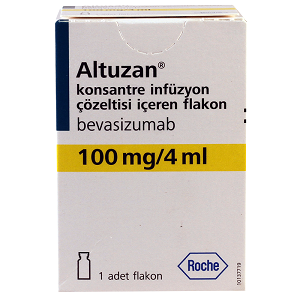Altuzan (Avastin ) 100 MG 4 ML
Altuzan (Avastin ) 100 MG 4 ML, AVASTIN®, in combination with intravenous 5‑fluorouracil‑based chemotherapy, is indicated for first- or second‑line treatment of patients with metastatic carcinoma of the colon or rectum. Avastin, in combination with carboplatin and paclitaxel, is indicated for first‑line treatment of patients with unresectable, locally advanced, recurrent or metastatic non-squamous, non-small cell lung cancer.
Altuzan (Avastin) 400 MG 16 ML, AVASTIN®, in combination with intravenous 5‑fluorouracil‑based chemotherapy, is indicated for first- or second‑line treatment of patients with metastatic carcinoma of the colon or rectum. Avastin, in combination with carboplatin and paclitaxel, is indicated for first‑line treatment of patients with unresectable, locally advanced, recurrent or metastatic non-squamous, non-small cell lung cancer.
The anti-tumor drug Avastin has proven itself in the treatment of severe cancer, such as metastatic cancers, namely:
– colorectal cancer,
– breast cancer,
– lung cancer,
– renal cell carcinoma,
– glioblastoma (brain cancer).
– The latest drug testing confirmed the possibility of using it in ovarian oncology.
– And also the specialists use the Avastin medical device in ophthalmology, with diabetic retinopathy, macular edema and tumors in the near-muscular region.
Contraindications Avastin:
Avastin can not be used for patients who:
– Hypersensitivity to the constituents of the drug.
– Diseases of the liver and kidneys.
– It is planned pregnancy or women who are already pregnant, as well as nursing mothers and young children.
Side effects:
Taking Avastin can cause side effects; if a change is detected, it is recommended to consult a specialist immediately, self-medication or drug cancellation is not advisable. possibly aggravation of the patient’s condition. So, among the side effects of the drug can be observed:
– Arterial hypertension, congestive heart failure, arterial thromboembolism, bleeding, deep vein thrombosis;
– Neurotropenia, leukopenia, anemia, febrile neurotropenia, thrombocytopenia;
– diarrhea, constipation, vomiting, nausea, anorexia, rectal bleeding, stomatitis;
– perforation of the gastrointestinal tract, intestinal obstruction, gastrointestinal disorders, abdominal pain;
– rhinitis, epistaxis, hypoxia, dyspnea, pulmonary thromboembolism;
– exfoliative dermatitis, dry or pigmented skin, palmar-plantar syndrome;
– visual impairment, increased lacrimation;
– Arthralgia, muscle weakness, pain in the muscles;
– proteinuria, urinary tract infections;
– asthenia, hyperthermia, increased fatigue, dehydration, pains of different localization, abscess, sepsis.
Interaction with other drugs:
Possible joint use with drugs: 5-FU-LV, carboplatin-paclitaxel, capecitabine or doxorubicin, irinotecan; capecitabine, oxaliplatin. There is no reliable data on the effect of Avastin on the pharmacokinetics of gemcitabine. A joint use with warfarin is also possible. With the use of Avastin (10 mg / kg every 2 weeks) in combination with sunitinib (50 mg, daily), cases of development of microangiopathic hemolytic anemia (MAGA) have been reported in patients with metastatic renal cell carcinoma. Avastin is pharmaceutically incompatible with solutions of dextrose.
Method of application and dosage:
The medical drug Avastin is used by intravenous infusion and only by a drip, an infusion is prohibited. Raise Avastin to the required volume you need 0.9% solution of sodium chloride, always in aseptic conditions. The finished solution should contain 1.4-16.5 mg / ml bevacizumada. The first dose of Avastin is given after the end of chemotherapy in the form of intravenous infusion for 90 minutes, subsequent doses can be administered after and before chemotherapy. If the patient has transferred the first infusion positively, then the time of the second can be reduced to 60 minutes. If the positive reaction persists, the next infusion is done within 30 minutes. If there are side effects from the procedures, then Avastin must be canceled, for a time or at all.
Special instructions:
Avastin treatment should be controlled by a professional doctor, and if any side effects are found, you should immediately contact a specialist and do not attempt independent treatment, or you can not cancel the drug yourself. The appointment of a drug such as Avastin should be taken by the attending oncologist, independently, without the knowledge of the doctor, the use of the drug is categorically prohibited. If in the course of therapy this drug is inscribed, then do not pay attention to all sorts of reviews, tk. they can be different and confuse you and adequately perceive the course of therapy. If Avastin is appointed, it can not be replaced by any analogues, professional doctors oncologists have long specialized in this industry and know best what to appoint in this or that case. And also an important point is that,
Form of issue:
Avastin is produced in vials of 4 and 16 ml with liquid for intravenous administration.
Storage conditions:
Store at a temperature of 2 to 8 degrees. Do not store in the refrigerator. Do not expose to direct sunlight. Divorced Avastin solution can not be stored for more than 2 days. Keep out of the reach of children.
Shelf life:
Altuzan (Avastin) 100 MG 4 ML, Altuzan (Avastin) 100 MG 4 ML, Altuzan (Avastin) 100 MG 4 ML

